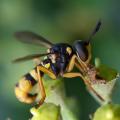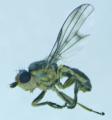Diptera.info :: Identification queries :: Diptera (adults)
Who is here? 1 guest(s)
|
Just two more empids
|
|
| Juergen Peters |
Posted on 22-05-2005 22:46
|
|
Member Location: northwest Germany Posts: 13813 Joined: 11.09.04 |
Hello! I need again some help regarding some Empididae. Thanks in advance! The first Empid was already photographed on May, 25th 2003. It was as large as Empis tesselata, but totally black.  The second picture I took on April, 23rd 2005, late in the evening on the wall of our house. This one was rather tiny (< 10 mm):  Best regards, Jürgen -=-=-=-=-=-=-=-=-=-=-=-=-=-=-=-= Juergen Peters Borgholzhausen, Germany WWW: http://insektenfo... -=-=-=-=-=-=-=-=-=-=-=-=-=-=-=-= |
| Paul Beuk |
Posted on 23-05-2005 06:58
|
|
Super Administrator Location: Netherlands Posts: 19311 Joined: 11.05.04 |
The top one is quite easy. In this part of the world there is only one larger species of Empis that might remind you of a Bibio and that is this one: Empis ciliata, the female has these distinctly feather legs. The second one is more difficult. It is a species of Rhamphomyia, as there is no fork in vein R4+5. It may be a species of the R. sulcata group but it is hard to say because too few details are visible in this dorsal view. Paul - - - - Paul Beuk on https://diptera.info |
| Juergen Peters |
Posted on 23-05-2005 19:34
|
|
Member Location: northwest Germany Posts: 13813 Joined: 11.09.04 |
Hello, Paul! Paul Beuk wrote: The top one is quite easy. In this part of the world there is only one larger species of Empis that might remind you of a Bibio and that is this one: Empis ciliata, the female has these distinctly feather legs. Thanks! So this older picture gets a name after all... :-) The second one is more difficult. It is a species of Rhamphomyia, as there is no fork in vein R4+5. It may be a species of the R. sulcata group but it is hard to say because too few details are visible in this dorsal view. Because of the size I too thought of a Rhamphomyia. I know this genus only since some weeks - thanks to the members of this forum :-)). Best regards, Jürgen -=-=-=-=-=-=-=-=-=-=-=-=-=-=-=-= Juergen Peters Borgholzhausen, Germany WWW: http://insektenfo... -=-=-=-=-=-=-=-=-=-=-=-=-=-=-=-= |
| Paul Beuk |
Posted on 23-05-2005 22:17
|
|
Super Administrator Location: Netherlands Posts: 19311 Joined: 11.05.04 |
Juergen Peters wrote: Because of the size I too thought of a Rhamphomyia. I know this genus only since some weeks - thanks to the members of this forum :-)). I am afraid that size does not really matter much. The only 'rule' I can think of is that the largest ones usally are Empis but after you get to the slightly smaller ones to the real small ones it can be either genus. Paul - - - - Paul Beuk on https://diptera.info |
| Juergen Peters |
Posted on 24-05-2005 05:00
|
|
Member Location: northwest Germany Posts: 13813 Joined: 11.09.04 |
Hello, Paul! Paul Beuk wrote: I am afraid that size does not really matter much. The only 'rule' I can think of is that the largest ones usally are Empis but after you get to the slightly smaller ones to the real small ones it can be either genus. Yes, another Empis I regularly find here, is rather small and fragile: Empis stercorea (but otherwise not to confuse with another species). At the beginning I found it hard to believe that this should be the same genus as the large and strong E. tesselata. Best regards, Jürgen -=-=-=-=-=-=-=-=-=-=-=-=-=-=-=-= Juergen Peters Borgholzhausen, Germany WWW: http://insektenfo... -=-=-=-=-=-=-=-=-=-=-=-=-=-=-=-= |
| Paul Beuk |
Posted on 24-05-2005 07:14
|
|
Super Administrator Location: Netherlands Posts: 19311 Joined: 11.05.04 |
Juergen Peters wrote: Yes, another Empis I regularly find here, is rather small and fragile: Empis stercorea (but otherwise not to confuse with another species). I hate to be a pest but unfortunately, there is a very similar species: E. aemula. The females are almost indistinguishable (you will need to compare them side by side) and the males can be separated by the genital characters. Both have a single median stripe on the mesonotum. And to be honest, there are even several others, like E. univittata. At the beginning I found it hard to believe that this should be the same genus as the large and strong E. tesselata. Actually, the true systematic classification into Empis and Rhamphomyia is a mess. The convenient classification is based on the absence or presence of the fork in R4+5 but in evolutionary terms some subgenera of Empis and Rhamphomyia are more closely related than they are to subgenera of their own genus. For example: Both the subgenera Empis (Empis) and Rhamphomyia (Pararhamphomyia) may not be what you might call single evolutionary units, but their species probably are all closer related to each other than that Empis (Empis) species are related to Empis (Xanthempis) (where E. stercorea belongs). So current classification is practical (most of the time, anyway) rather than 'biological'. Maybe it will be sorted out some day... Paul - - - - Paul Beuk on https://diptera.info |
| Jump to Forum: |
















